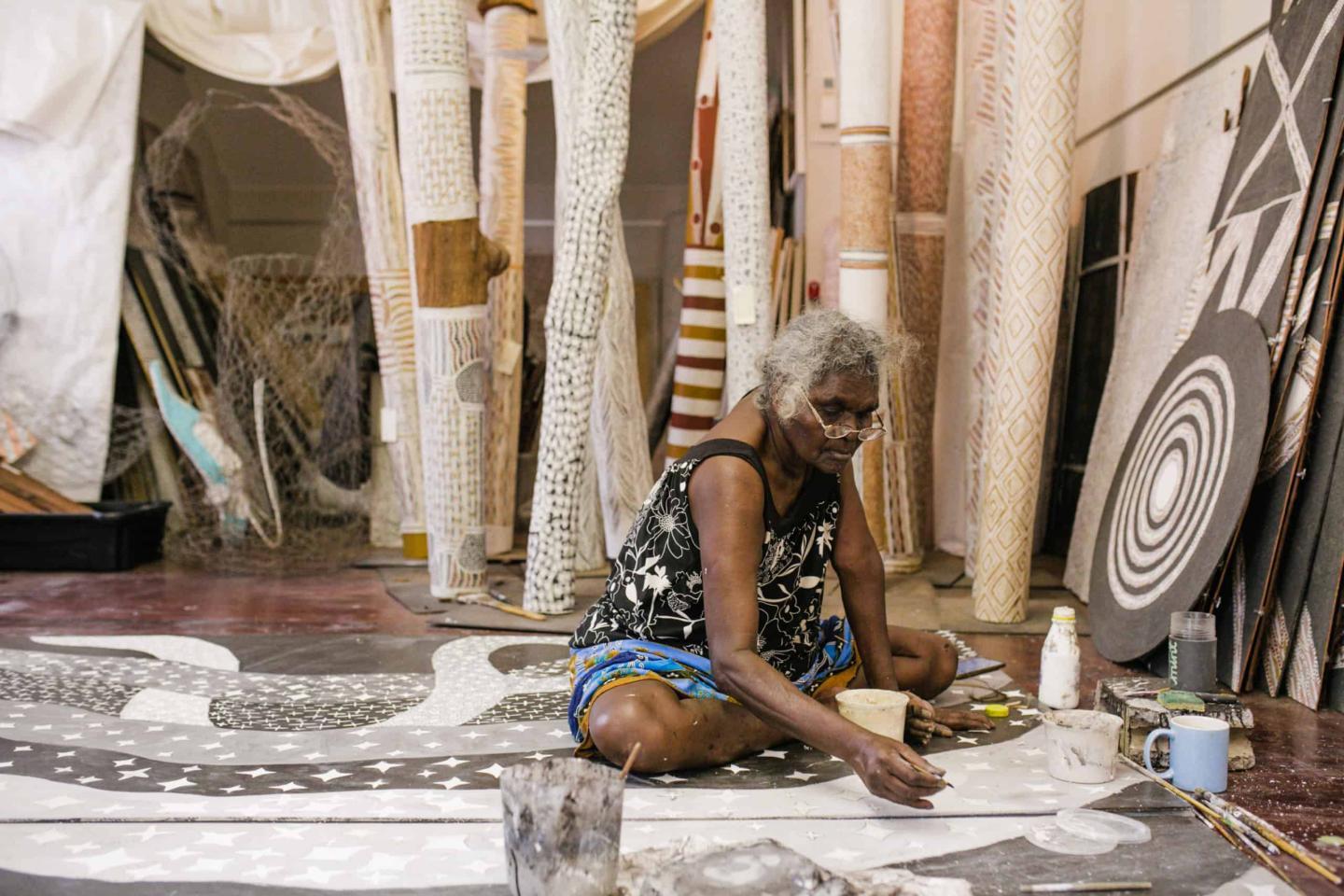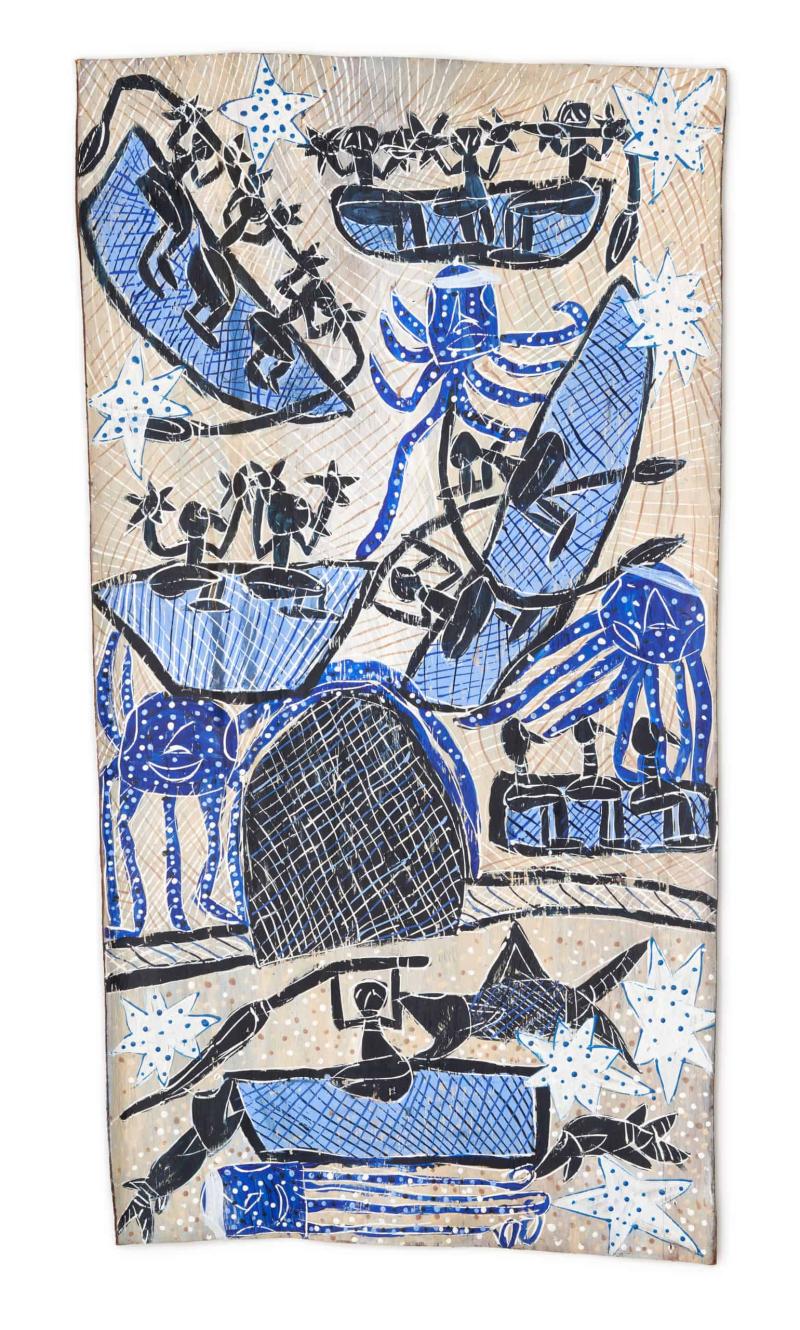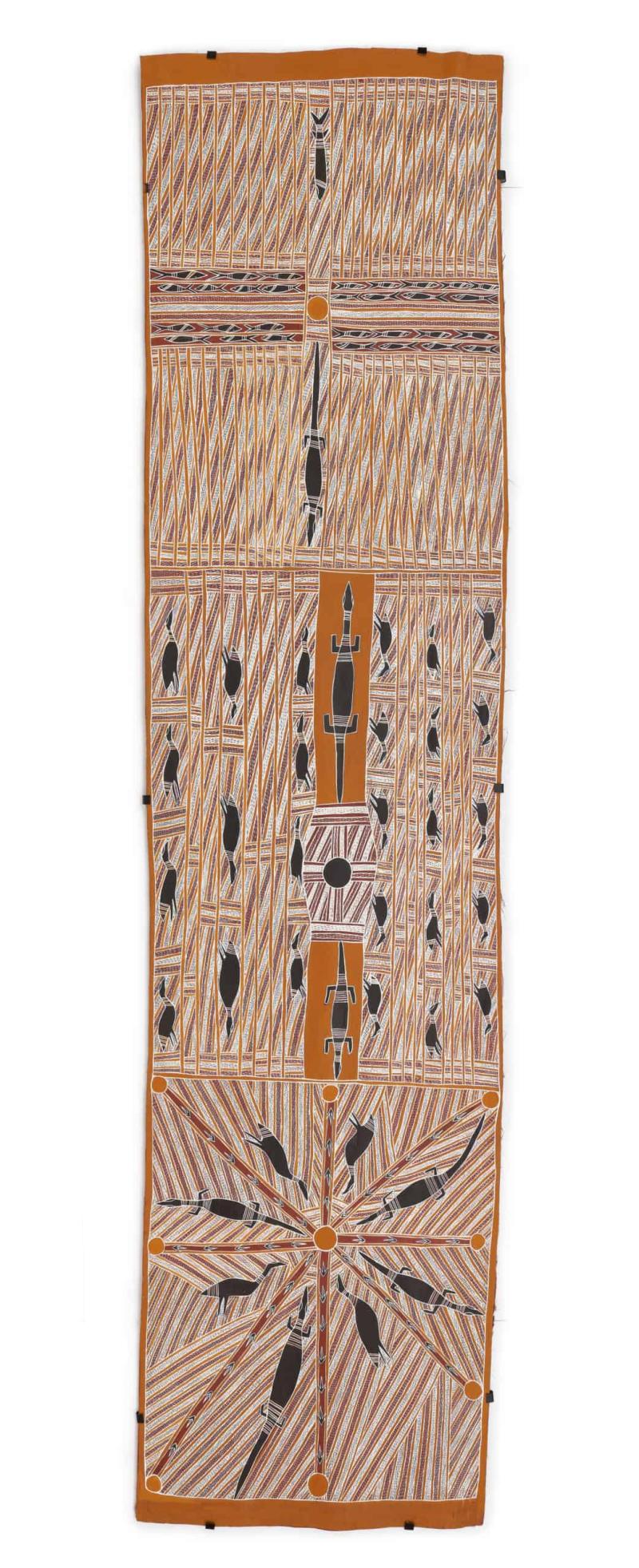Landmark exhibition of Aboriginal Australian bark painting returns to its home institution in February 2024
The Fralin Museum of Art at the University of Virginia showcases Indigenous art in Maḏayin: Eight Decades of Aboriginal Australian Bark Painting from Yirrkala and an exhibition of slit drums of New Guinea

CHARLOTTESVILLE, Va. – One of the most significant touring exhibitions of Aboriginal Australian art ever staged returns to the city where it was first envisioned. The Fralin Museum of Art at the University of Virginia presents “Maḏayin: Eight Decades of Aboriginal Australian Bark Painting from Yirrkala” from Feb. 3-July 14, 2024. The exhibition features more than 50 masterpieces of ochre painting on eucalyptus bark, many of which have never been on view outside of Australia.
Drawn from the Kluge-Ruhe Aboriginal Art Collection of the University of Virginia and important museum and private collections in the United States and Australia, “Maḏayin” was curated by a team of Yolŋu Aboriginal Australian artists and knowledge holders from northern Australia. The idea for the exhibition was conceived in 2015 by Yolŋu artist and leader Djambawa Marawili during a residency at Kluge-Ruhe. After encountering the rich collection of paintings from his homelands held at the University of Virginia (UVA), he declared the need for an exhibition that would share these paintings with the world. Over the next seven years Marawili led a team of Yolŋu curators, collaborating with Kluge-Ruhe to create this deep exploration of historic and contemporary bark painting.
“‘Maḏayin’ originated with Yolŋu people. Yolŋu shaped the curatorial rationale, developed the exhibition checklist and wrote the exhibition didactics and catalog essays,” said Margo Smith, the director of Kluge-Ruhe. “We do not pretend to understand Yolŋu art in the same ways Yolŋu knowledge holders do. ‘Maḏayin’ is about recognizing and appreciating both their knowledge and the limits we encounter in fully comprehending Yolŋu culture.”
The title of the exhibition, “Maḏayin,” is a Yolŋu word that means both sacred and beautiful. The exhibition includes historic works dating as early as 1935 as well as newly commissioned paintings produced especially for the exhibition. Featuring four generations of artists, it includes some of Australia’s most acclaimed Indigenous artists, including Woŋgu Munuŋgurr, Wandjuk Marika OBE, Noŋgirrŋa Marawili and Nyapanyapa Yunupiŋu.
Marawili notes, “It is very important to show these old paintings alongside contemporary works, to recognize that we Yolŋu have enduring patterns that connect us to our Country. I am proud to make this connection to the United States. The art went first—all those old paintings in the museums. What follows is reconciliation and the passing knowledge to America through our art. Because art is important to us. It represents our mind and our soul.”
“Maḏayin” will be on view alongside an exhibition of garamut — slit drums from New Guinea. The slit drum exhibition has been developed by The Fralin in collaboration with UVA anthropology professor Lise Dobrin and internationally renowned scholar and curator Andrew Moutu. Garamut are the most important instruments in the Sepik River region. The rhythmic “voice” of the drums have long been used by the people of the Sepik area to announce meetings, call individuals or issue warnings across villages. The sound of the garamut is central to daily life, providing the beating heart of Sepik village life.
“The intricate technique and layered, ancestral narratives reflected in these objects are captivating, and we look forward to sharing these important works with visitors,” said M. Jordan Love, the interim co-director and Carol R. Angle academic curator at The Fralin Museum of Art. “These two exhibitions will take over the majority of our galleries. The breadth and variety on display will give students and visitors to the UVA grounds the opportunity to richly experience and learn about the cultures of creativity in this part of the world.”
Part of a sweeping national tour, “Maḏayin” premiered at the Hood Museum of Art, Dartmouth in September 2022 to great acclaim, hailed by The New York Times as one of the must-see exhibitions of the season. American University Museum at the Katzen Arts Center in Washington, D.C. hosted the exhibition from February-May 2023 and it will continue to the Asia Society, New York in September 2024 following the presentation at The Fralin.
“Maḏayin: Eight Decades of Aboriginal Australian Bark Painting from Yirrkala” is organized by the Kluge-Ruhe Aboriginal Art Collection of the University of Virginia in partnership with the Buku-Larrŋgay Mulka Centre, Yirrkala. The Hood Museum collaborated on the exhibition’s content and presentation. “Maḏayin” is supported by the National Endowment for the Humanities, the Australian Government Office for the Arts, the Andy Warhol Foundation for the Visual Arts, Australia Council for the Arts, the Mellon Foundation, The Embassy of Australia, the National Endowment for the Arts, Australian Capital Equity – the Kerry Stokes Collection, Crozier Fine Arts, the Jefferson Trust, UVA Arts Endowment and Fondation Opale.
The exhibition has been made possible through the longstanding relationship between Kluge-Ruhe and the Yolŋu community at Yirrkala. “Maḏayin” is accompanied by a comprehensive 348-page bilingual catalog (in Yolŋu Matha and English) distributed internationally by DelMonico Books D.A.P and a digital resource Maḏayin.kluge-ruhe.org.
About The Fralin Museum of Art at the University of Virginia
Established in 1935, the University of Virginia Art Museum became The Fralin Museum of Art in 2012 in honor of a bequest of American art and service to the University by Cynthia and W. Heywood Fralin. The Museum maintains a collection of more than 13,000 works of art, including American and European painting, works on paper and sculpture from the 15th through the 20th centuries; art from the ancient Mediterranean; Asian art; and Native and ancient American art. Housed in the historic Bayly Building near the Rotunda on the landmark UVA campus, The Fralin is dedicated to serving the widest possible audiences and engaging comprehensive visual education to enhance its visitors’ understanding of world cultures. Throughout the year, the Museum presents a diverse selection of exhibitions, programs, research and events that bring the University and broader community together.
About the Kluge-Ruhe Aboriginal Art Collection of the University of Virginia
The Kluge-Ruhe Aboriginal Art Collection expands knowledge and understanding of Indigenous Australian arts and cultures to cultivate greater appreciation of human diversity and creativity. With a collection of more than 3,500 objects, Kluge-Ruhe offers a variety of rich programming on-site and digitally. Its well-established residency programs bring eminent Indigenous artists, curators and knowledge holders to Charlottesville to engage with the University of Virginia community and the public. Kluge-Ruhe is committed to expanding Indigenous leadership throughout the museum and creating high-value, immersive experiences to serve broader audiences.


